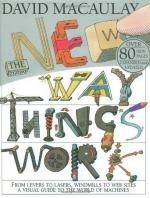
|
| Name: _________________________ | Period: ___________________ |
This test consists of 15 multiple choice questions and 5 short answer questions.
Multiple Choice Questions
1. What imparts movement into the air or water around them on a ship?
(a) Propellers.
(b) Bits.
(c) Cams.
(d) Levers.
2. How does a wedge move an object up an inclined plane?
(a) It uses the effect of gravity.
(b) It doesn't ; the wedge moves the plane itself to raise an object.
(c) It forces the object to reduce the effects of gravity.
(d) It lowers the plane so the object slides.
3. What is an absence of substance?
(a) Gravity.
(b) A vacuum.
(c) Outer space.
(d) Matter.
4. What is the most common form of inclined plane found in machines?
(a) The rods.
(b) The wedge.
(c) The rocker.
(d) The pully.
5. What emits both infrared and light rays?
(a) A light bulb.
(b) The sun.
(c) A planet.
(d) The moon.
6. What do the double walls of a thermos enclose?
(a) A vacuum.
(b) Argon.
(c) Nitrogen.
(d) Oxygen.
7. In flying, what is used to overcome weight from gravity?
(a) Lift created by the nose.
(b) Lift created by the airfoil.
(c) Lift created by the rudder.
(d) Lift created by the tiller.
8. What causes sideways movements of a ship?
(a) Rods.
(b) Cams.
(c) Jone's principle.
(d) Thrusters and stabilizers.
9. What does one have to understand in order to understand the way things work?
(a) The terms of physics.
(b) The underlying principle.
(c) The function of something.
(d) The reason something is made.
10. What causes expansion?
(a) Heat.
(b) Inertia.
(c) Gravity.
(d) Cold.
11. How many forces hold things together?
(a) Four.
(b) One.
(c) Two.
(d) Three.
12. What does increasing heat do to molecules?
(a) Nothing.
(b) It increases the movement of molecules.
(c) It slows them down.
(d) It makes them break apart.
13. What is the result of a collision of molecules which break on impact forming new and different molecules?
(a) Fusion.
(b) Radiation.
(c) Fission.
(d) Combustion.
14. What is one example the author uses of a wedge?
(a) A type of door stop.
(b) A ship's ramp.
(c) An escalator.
(d) A block and tackle system.
15. What forms a molecule?
(a) Two or more atoms.
(b) Six or less atoms.
(c) Five or more atoms.
(d) One or more atoms.
Short Answer Questions
1. What do compound levers contain?
2. What is the density of salt water compared to fresh water?
3. What is applied to a lever to make it move?
4. Through what can heat not travel?
5. What is a substance that contains only one type of atom?
|
This section contains 441 words (approx. 2 pages at 300 words per page) |

|




